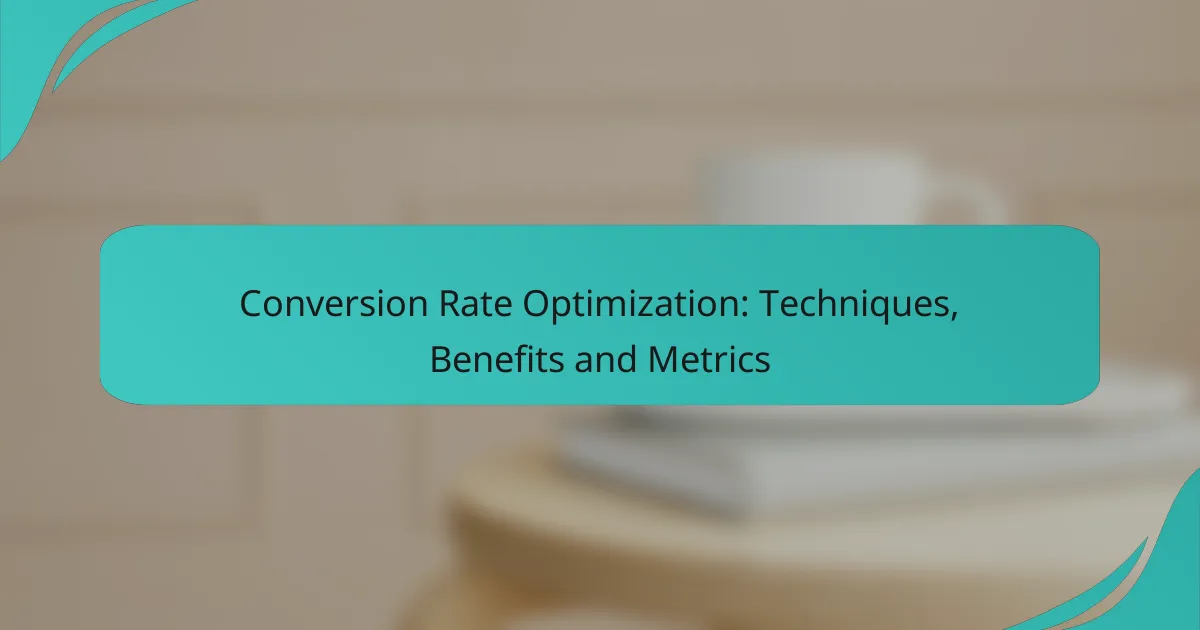Data-driven marketing empowers businesses to make informed decisions by utilizing real customer insights rather than relying on assumptions. By implementing strategies that leverage customer data, companies can optimize their campaigns, enhance customer experiences, and ultimately improve engagement and conversion rates. This approach not only maximizes return on investment but also fosters a deeper understanding of customer needs and preferences.

What are the key strategies for data-driven marketing?
Key strategies for data-driven marketing include leveraging customer insights to inform decisions, optimizing campaigns based on data analysis, and enhancing customer experiences through targeted approaches. These strategies help businesses improve engagement, increase conversion rates, and maximize return on investment.
Customer segmentation
Customer segmentation involves dividing a customer base into distinct groups based on shared characteristics such as demographics, behavior, or preferences. This allows marketers to tailor their messaging and offers to specific segments, improving relevance and effectiveness.
To implement effective segmentation, consider using data from surveys, purchase history, and online behavior. Tools like CRM systems can help manage and analyze this data, enabling more precise targeting.
Predictive analytics
Predictive analytics uses historical data and statistical algorithms to forecast future outcomes. In marketing, this can help identify potential customer behaviors, such as likelihood to purchase or churn, allowing businesses to proactively address these trends.
Utilizing predictive models can lead to more informed decision-making. For example, retailers might analyze past sales data to predict which products will be popular in upcoming seasons, enabling better inventory management.
Personalization techniques
Personalization techniques tailor marketing messages and experiences to individual customers based on their data. This can include personalized emails, product recommendations, and targeted ads that reflect a customer’s past interactions with the brand.
Effective personalization can significantly enhance customer engagement. For instance, using a customer’s name in email campaigns or suggesting products based on previous purchases can create a more relevant experience, increasing the likelihood of conversion.
Multi-channel integration
Multi-channel integration refers to the seamless coordination of marketing efforts across various channels, such as social media, email, and websites. This strategy ensures that customers receive consistent messaging and experiences, regardless of the platform they engage with.
To achieve effective integration, businesses should utilize data analytics to track customer interactions across channels. This helps in understanding customer journeys and optimizing touchpoints for better engagement.
Content optimization
Content optimization involves refining marketing content to improve its performance based on data insights. This can include adjusting headlines, images, and calls to action to better resonate with the target audience.
Regularly analyzing content performance metrics, such as click-through rates and engagement levels, can guide optimization efforts. For example, A/B testing different versions of a landing page can reveal which elements drive higher conversions, allowing for data-driven improvements.

How can businesses implement data-driven marketing in the UK?
Businesses in the UK can implement data-driven marketing by leveraging customer data to inform their marketing strategies, optimize campaigns, and enhance customer experiences. This approach involves using various tools and techniques to collect, analyze, and apply data effectively.
Utilizing CRM systems
Customer Relationship Management (CRM) systems are essential for data-driven marketing as they centralize customer information and interactions. By tracking customer behavior and preferences, businesses can tailor their marketing efforts to meet specific needs.
When implementing a CRM, consider platforms that integrate well with existing tools and provide robust analytics features. Popular options in the UK include Salesforce and HubSpot, which offer functionalities to segment customers and automate communications.
Leveraging social media analytics
Social media analytics tools allow businesses to gather insights from their online presence, helping to understand audience engagement and preferences. By analyzing metrics such as likes, shares, and comments, companies can refine their content strategy to better resonate with their target market.
Utilize platforms like Hootsuite or Sprout Social to monitor performance and identify trends. Regularly reviewing analytics can inform decisions on which types of content generate the most engagement and guide future marketing campaigns.
Adopting marketing automation tools
Marketing automation tools streamline repetitive tasks and enhance the efficiency of data-driven marketing efforts. These tools can automate email campaigns, social media posting, and lead nurturing processes, allowing businesses to focus on strategy and creativity.
Consider tools like Mailchimp or Marketo, which offer features for tracking customer interactions and personalizing marketing messages. Ensure that your automation strategy aligns with your overall marketing goals to maximize effectiveness and avoid overwhelming customers with excessive communications.

What are the benefits of data-driven marketing?
Data-driven marketing offers businesses the ability to make informed decisions based on real insights rather than assumptions. By leveraging data, companies can optimize their strategies to achieve better results and enhance customer satisfaction.
Improved ROI
Data-driven marketing significantly enhances return on investment (ROI) by allowing businesses to allocate resources more effectively. By analyzing past campaigns, companies can identify which strategies yield the highest returns and focus their efforts accordingly.
For instance, a business may find that email marketing campaigns targeting specific customer segments result in higher conversion rates compared to generic outreach. This insight enables them to invest more in successful channels, leading to improved financial performance.
Enhanced customer insights
Utilizing data allows businesses to gain deeper insights into customer behavior and preferences. By analyzing customer interactions and feedback, companies can tailor their offerings to meet specific needs, improving overall satisfaction.
For example, tracking purchasing patterns can reveal trends that inform product development or promotional strategies. Businesses that understand their customers’ preferences can create personalized experiences, fostering loyalty and repeat business.
Increased engagement rates
Data-driven marketing strategies often lead to higher engagement rates as they enable more targeted and relevant messaging. By understanding what resonates with their audience, businesses can craft campaigns that capture attention and encourage interaction.
For instance, using analytics to determine the best times to send communications can significantly boost open and click-through rates. Engaging content tailored to specific demographics or interests can further enhance customer interaction, driving better outcomes for marketing efforts.

What tools are essential for data-driven marketing?
Essential tools for data-driven marketing include platforms that enable tracking, analyzing, and optimizing marketing efforts based on data insights. These tools help marketers understand customer behavior, measure campaign performance, and make informed decisions to enhance ROI.
Google Analytics
Google Analytics is a powerful tool that tracks website traffic and user behavior. It provides insights into visitor demographics, acquisition channels, and engagement metrics, allowing marketers to assess the effectiveness of their campaigns.
To get started, set up tracking codes on your website and define key performance indicators (KPIs) relevant to your goals. Regularly review reports to identify trends and adjust strategies accordingly.
Common pitfalls include neglecting to set up goals or failing to segment data, which can lead to missed opportunities for optimization.
HubSpot
HubSpot is an all-in-one marketing platform that integrates CRM, email marketing, and content management. It allows businesses to automate marketing tasks and analyze customer interactions across various channels.
Utilizing HubSpot effectively involves creating targeted campaigns based on user behavior and lifecycle stages. Leverage its analytics to refine your approach and improve lead nurturing processes.
Be cautious of over-automating communications, as this can lead to a lack of personalization and engagement with your audience.
Tableau
Tableau is a data visualization tool that helps marketers transform complex data sets into interactive dashboards. It enables users to visualize trends and patterns, making it easier to communicate insights to stakeholders.
To maximize Tableau’s potential, connect it to various data sources and create visualizations that highlight key metrics. This can facilitate data-driven discussions and strategic planning.
Avoid cluttering dashboards with too much information; focus on clarity and actionable insights to ensure your audience can easily interpret the data.

What metrics should be tracked in data-driven marketing?
In data-driven marketing, tracking key metrics is essential for evaluating performance and making informed decisions. Important metrics include conversion rates, customer acquisition cost, and customer lifetime value, each providing insights into different aspects of marketing effectiveness.
Conversion rates
Conversion rates measure the percentage of users who take a desired action, such as making a purchase or signing up for a newsletter. This metric is crucial as it indicates the effectiveness of marketing campaigns and website performance. A typical conversion rate can vary widely, often ranging from 1% to 5%, depending on the industry.
To improve conversion rates, consider A/B testing different elements of your marketing strategy, such as call-to-action buttons or landing page designs. Regularly analyzing user behavior can also help identify barriers to conversion, allowing for targeted improvements.
Customer acquisition cost
Customer acquisition cost (CAC) refers to the total cost associated with acquiring a new customer, including marketing expenses and sales efforts. Understanding CAC is vital for assessing the efficiency of your marketing strategies. A common benchmark is to aim for a CAC that is less than one-third of the customer’s lifetime value.
To lower CAC, focus on optimizing your marketing channels and targeting the right audience. Utilizing data analytics can help identify which channels yield the best return on investment, allowing for more strategic budget allocation.
Customer lifetime value
Customer lifetime value (CLV) estimates the total revenue a business can expect from a single customer throughout their relationship. This metric helps businesses understand how much they can afford to spend on acquiring customers while remaining profitable. A typical CLV can range from a few hundred to several thousand dollars, depending on the business model.
To maximize CLV, focus on customer retention strategies such as loyalty programs and personalized marketing. Regularly engaging with customers through email campaigns or social media can enhance their experience and encourage repeat purchases, ultimately increasing their lifetime value.







